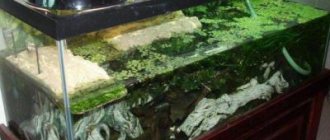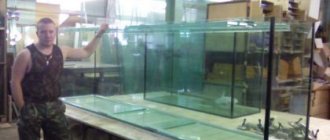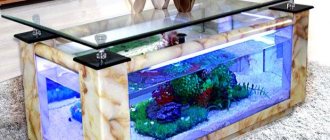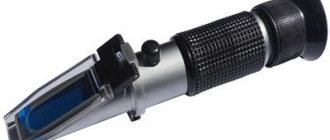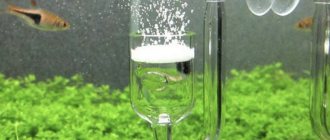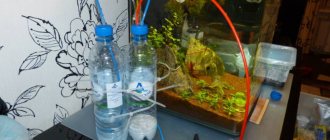Glass rectangular aquariums with fish, decorating the interior of homes, offices and shopping centers, are familiar to every fan of the underwater world. Having carefully studied the design of the tank, many fish holders come to the conclusion that they can make an aquarium themselves using glass, the necessary tools and glue. Although stores display a wide range of containers for keeping fish, not every aquarist can choose a model to their liking, and some are confused by the price of artificial reservoirs. In addition, knowing how to glue an aquarium correctly, you can make money by selling homemade containers. There are some rules and nuances that will help you learn how to make an aquarium with your own hands.
Making an aquarium with your own hands: when is it profitable?
Perhaps for novice aquarists just joining the ranks of fans of the underwater depths, the question of how to make an aquarium with your own hands will seem strange. After all, pet stores and Internet sites offer a wide range of models of artificial ponds: giant and small, rectangular and round, with and without lids. However, despite such an abundance of tanks, many experienced aquarists prefer to make a homemade aquarium.
The decision to glue an aquarium at home has many reasons. For example, a fish holder lives in an area remote from the city, and transporting a fragile glass container, such as a 150 liter aquarium, causes difficulties. Some owners make structures for sale, earning money at the same time. But the main reason why most aquarists decide to make an aquarium with their own hands is the joy of the work done and the desire to save money. But there are also models that are quite difficult to make on your own, for example, an aquarium partition.
Reviews
Reviews from aquarists about homemade products are positive. They believe that everyone will make a fish container. The main thing is to follow all the rules and carefully glue the surfaces. But there are people who consider the independent production of these structures to be a waste of time, because it is faster and easier to buy a ready-made structure.
Materials for work
To make an aquarium with your own hands, you first need to stock up on the necessary materials and tools for the job. For construction you will need:
- Silicone glue gun.
- Grindstone.
- A sharp blade or thin knife.
- Paper napkins, sponges and clean cloth.
- Degreaser.
- Ruler or tape measure.
- Glass cutter.
- Masking tape.
In addition to these items, you will need newspapers on which the structure will dry, and glass clamps that will firmly fix the walls of the container until it dries. Having prepared the necessary parts, all that remains is to choose the right glass and glue to create a homemade product.
What tools will you need?
If the desire to create a fish house on your own has overcome the fear of failure, you can move on to preparation. First you need to select all the necessary tools. To assemble the aquarium you will need:
- Metal corners.
- Clamps, it is better to take a small size.
- Silicone, if rods are used, then a heat gun will be required.
- Masking tape.
- Knives.
- Brushes, spatulas.
- Backings for gaps.
Please note: for assembly you must prepare a perfectly flat surface.
Glass selection
Successful gluing of an aquarium depends on two things: the correct choice of glass and glue, and the attentiveness and leisure of the owner. Correctly selected glass for assembling the structure already guarantees ½ successful production. The material from which the aquarium is glued must meet the requirements: provide a clear view and withstand the onslaught of liquid. If glass materials are chosen incorrectly, this will lead to structural failure and death of the tank residents.
To select glass for production, you should familiarize yourself with the selection rules:
- To build a pond at home, silicate glass is used, not organic glass. The latter type is considered synthetic, so there is a risk that it will release dangerous chemical elements into the water that will negatively affect the well-being of the fish. In addition, organic glass is inferior to silicate glass in external characteristics: it is scratched and quickly becomes cloudy.
- Having learned that only silicate glass is suitable for construction, you should study the specifics of this type in more detail. Silicate glass is divided into two types: window glass and display glass. The first option for the construction of artificial reservoirs is categorically not suitable, since the window type distorts the view and is too fragile. Therefore, they choose a display case for the construction: shiny, durable and smooth. The cost will be more expensive, but it is better not to be greedy in this matter, because the life of the fish and the reputation of the manufacturer depends on the right choice if the aquarium is put up for sale.
- The grade plays a significant role in the choice of glass. There are eight glasses: from M1 and ending with M8. To make a glass aquarium with your own hands, you need the highest quality - grade M1. If this option is not possible, you can purchase M2, or in the most extreme cases - M3. It is unacceptable to use low varieties, since they will not withstand the weight of water and will simply burst, burying flora, fish and decorations.
- When purchasing premium silicate glass, it is important not to lose vigilance and carefully examine the material. If there are the slightest chips, scratches or cracks, you cannot purchase glass! Even a tiny defect will lead to negative consequences: breakage and destruction.
- Used glass cannot be used for the construction of structures. Like any other material, glass surfaces have a service life and are subject to natural wear and tear, so using used materials will lead to negative results.
In addition to these rules, attention should be paid to the thickness of the glass. If the owner chooses the width, length and height independently, then the thickness of the glass pieces is determined using a special table, where h is the height and l is the length.
If a large aquarium is being built, then stiffening ribs will be required. These are additional components that help the structure withstand fluid pressure, preventing the walls from sagging. The stiffening ribs are installed at right angles, which allows you to increase the strength of the container and install a glass lid for the aquarium.
Separately, it should be noted such a nuance as cutting glass. If the aquarist does not have experience in this matter, it is better to entrust the work to professionals, since inept actions will lead to sad results.
Equipment:
- Flora. For a narrow aquarium, long-stemmed algae are suitable. Slow growing species are acceptable. They should not grow luxuriantly. An excellent choice is tropical Cryptocoryne, Anubias from the Araceae family, perennial and unpretentious Vallisneria, Echinodorus. To make maintenance easier, choose artificial plants.
- Fauna. For a narrow and large aquarium, sedentary fish with a flattened body are suitable. Another option is small fish that live in schools. Choose anios, lalius, angelfish, neons, guppies, characins or barbs.
- Decor. Should be narrow and not bulky. Select soil, stones, small figures (in the form of a castle, ancient amphorae), shells. The decor is chosen taking into account the preferences of the fish. Some inhabitants need corals for shelter, others will use shells or ceramic caves, and still others will feel good without any shelter.
- Equipment. It is selected depending on the volume. You need an ultraviolet sterilizer, a carbon dioxide supply system, a cooling or heating system, an ozonizer, and a cooler. Depending on the design, the filter is placed inside the aquarium or outside. Choose a quiet model. A compressor is needed if a filter without an aeration function is installed. If you choose a compressor with several air outlets, you will be able to place air sprayers in different areas of the aquarium. A heater is needed for warm-water fish; if the fish are cold-water, there is no need to heat the water. It is enough to install a thermometer. It will allow you to track your temperature.
Important! It is necessary to correctly calculate the number of individuals for a picture aquarium. There should be two liters of water per centimeter of the fish’s body. Accordingly, the fewer fish you choose, the more will fit in the aquarium. It is not recommended to stock cichlids, catfish and goldfish. They love to pick at the soil and nibble on algae, so they will have to clean up more often.
Create a picture aquarium with your own hands - our instructions show how to do it quickly and easily. As a result, you will receive not only pets, but a grandiose decoration that will cause surprise and admiration among guests and household members.
Glue selection
How to glue a glass aquarium is an important question, since the strength and durability of the structure depends on the correct choice of the adhesive mixture. There are many types of glue that can be used to connect glass edges together. But to make the aquarium durable and reliable, the adhesive must meet the following requirements:
- Safety.
- Strength and elasticity.
- Aesthetic appearance.
- Rapid grasping.
- Ease of use.
- Durability.
- High degree of adhesion.
Silicone sealant meets these requirements, thanks to which you can make a durable and reliable tank. Before gluing the aquarium with silicone sealant with your own hands, it is important to pay attention to the composition of the glue. The composition should not contain impurities, and the substance itself should not be antibacterial, otherwise the fish may be harmed.
Silicone sealant is available in three colors:
- White – When using this shade, it is important to note that the design may appear unfinished.
- Unpainted - used to create small tanks with a capacity of up to 100 liters.
- Black – used for gluing bulky structures, it looks elegant and noble.
The following brands of sealants are considered the most popular and reliable:
- Dow Corning 911.
- Tytan.
- Soudal Silirub AQ.
What else should you pay attention to?
- In regions with hard water, glass may become covered with a white limescale deposit. To eliminate this, use Tetra EasyWipes. They are safe for occupants and are suitable for use on both the outside and inside of glass.
- It is very convenient to use magnetic scrapers for cleaning glass.
- If you have live plants in your aquarium, they require additional care.
Follow these simple tips and your hobby will bring you only joy and pleasure!
Tetra General Tonic Tetra Contralck Sidex Tetra Bactozyme Tetra Vital Tetra NitrateMinus Tetra AquaSafe Hydrogen Peroxide
How to glue an aquarium
Artificial reservoirs for keeping fish come in different sizes and shapes, but for the first time you should give preference to a rectangular aquarium, the manufacture of which is simple and convenient. There are two ways to glue an aquarium at home:
- The walls are glued to the bottom of the tank.
- The glass is glued around the bottom.
Both methods do not differ from each other in terms of reliability and service life. Having chosen the first method and prepared the necessary materials, you can begin gluing the parts.
How to properly glue an aquarium:
- The first step is to sharpen the edges of the glass so as not to get hurt during assembly. To do this, the glass faces are transferred to a bathtub, the bottom of which is covered with a soft and clean cloth, the container is filled with water and the piece of glass is placed. Having moistened the sharpening stone, they carefully process the edges. The cut must remain intact, otherwise the silicone sealant will not be able to adhere tenaciously.
- Having completed the processing of the edges, carefully remove the glass and wipe it dry with a clean towel. After this, the edges are treated with a disinfectant.
- As preparation is completed, they begin responsible actions - gluing surfaces. The bottom of the future tank is carefully laid on the newspaper, then sealant is applied to the end of the front wall using a gun, and the glass is carefully placed on the bottom of the tank, gently and lightly pressing. If excess glue appears, then there is no need to remove the sealant - a double seam is used for strength.
- The side walls are glued in the same way, except that their vertical ribs are lubricated with sealant. The resulting structure is left to dry for 24 hours, but sometimes it takes more time for the glue to set well.
- After the sealant has dried, clamps are installed to glue the aquarium together if an impressive container is being built. A day later, after all the parts are securely glued, the excess adhesive mixture is eliminated using a sharp knife or blade.
- The assembled aquarium is checked for reliability and leaks. To do this, fill the container with water and carefully inspect the joints. If there is still a leak, you can try to fix it by pressing a little glue into the weak spot. After this, you can begin to launch an artificial reservoir and stock it with fish and shellfish.
When assembling the fish tank, safety precautions should be observed by wearing protective gloves during installation and manufacturing.
Possible problems and solutions when using
- Leak. An aquarium can leak in two cases: either the glass was originally purchased with cracks, or the seams between the sheets are of poor quality. To eliminate the problem we use sealants.
- Stains on the glass. Stains remain after glue or acetone. You can remove them with an ordinary dry cloth, or in the case of dried glue, with a small knife. To prevent streaks, we use alcohol to degrease the adhesive surfaces and use masking tape, which prevents the glue from spreading.
Aquarium cover
The aquarium lid is an element without which the design cannot be completed. The coating provides protection for energetic shellfish and active fish that jump to the surface and fall down to die. However, how to make an aquarium lid yourself? The simplest and most economical version of a homemade lid is a thin plastic sheet that is installed on the stiffeners.
If the owner wishes, a protective covering can be constructed from silicate glass or durable plastic by installing lighting. For convenience, a handle is attached to the lid to conveniently open/close the tank. To avoid damage to the top edge of the glass, construct a soft layer of sealant. In addition, it is important to first measure the parameters of the aquarium so that the lid fits in size and looks harmonious.
Making an aquarium at home for the first time may seem daunting, but with patience and detailed instructions, assembling the tank is not difficult. The main thing is to choose high-quality materials so that the structure becomes a reliable refuge for colorful fish, exotic shellfish and underwater flora. Having gotten your hands on making artificial ponds, you can turn this hobby into a profitable business by starting to produce aquariums at home.
Planning installation
Should you install it yourself or hire a professional? First, you will need to schematically depict the interior of the room in which the aquarium will be installed in the wall, with this new detail. Next, you can plan which part of the work you can do yourself, and which issues will require professional advice or assistance.
The easiest way is to install a rectangular or square container with water for fish into the wall. In this case, the side parts of the aquarium can protrude outward or form a single unit with the wall.
For a smooth outline, aquariums with rounded convex sides are better suited. The combination of rounded shapes with pastel walls will add romance to the room. Ideal for a bedroom or lounge. A wall-mounted aquarium with blunt protrusions without curves will look good in a modern interior with clear straight lines and geometric shapes.
Aquarium in the wall in the living room
Aquarium in the wall in high-tech style
If you plan to build an aquarium into the wall yourself, it will be easiest to use the classic design option. A tank installed flush with the wall, without protrusions, is considered universal. It can be easily secured and decorated using planks that match the style of the room.
Aquarium in the wall in the interior
Aquarium in the wall between the kitchen and living room
A flat aquarium on the wall should be proportionate to the area of the room and its furnishings. An aquarium that is too large will bulge and attract undue attention from guests. It shouldn't be this way. In a small room with low ceilings, it is more appropriate to place small aquariums. A colorful aquarium can suppress the cozy atmosphere in a small room and act as an irritant.
However, there are exceptions. For example, in a poorly lit room, a wall-hung aquarium with lighting can become an additional “window.” The aquarium is designed in the form of a window in a minimalist style. The internal lighting in it should be of high quality, which has a beneficial effect on the life activity of the inhabitants of the aquarium.
Square aquarium in the wall
Aquarium in the wall in the apartment
Summarize
In fact, of course, you can glue the aquarium yourself in a simpler way, simply by squeezing the sealant onto the edge of one glass and pressing it against the other. The method described in this article is indeed more labor-intensive, and also consumes a lot of sealant. At the same time, the seams of an aquarium glued in this way look much neater. Don’t forget that an aquarium is not just a habitat for fish, but also a decoration for your apartment. Therefore, the seams of the aquarium must be reliable, smooth and beautiful.
Cleaning seams
The aquarium is almost ready, but it doesn't look very neat. Drops and stray sealant smears can be removed from the glass using blades. After this you need to clean the seams. This refers to the process of removing excess sealant along the seams of the aquarium. This should be done carefully so as not to damage the seams or cut yourself.
Before introducing the inhabitants of the underwater world into the aquarium, be sure to rinse it thoroughly, then fill it with water and make sure that it does not leak.
Empty 30 l aquarium filled with water



